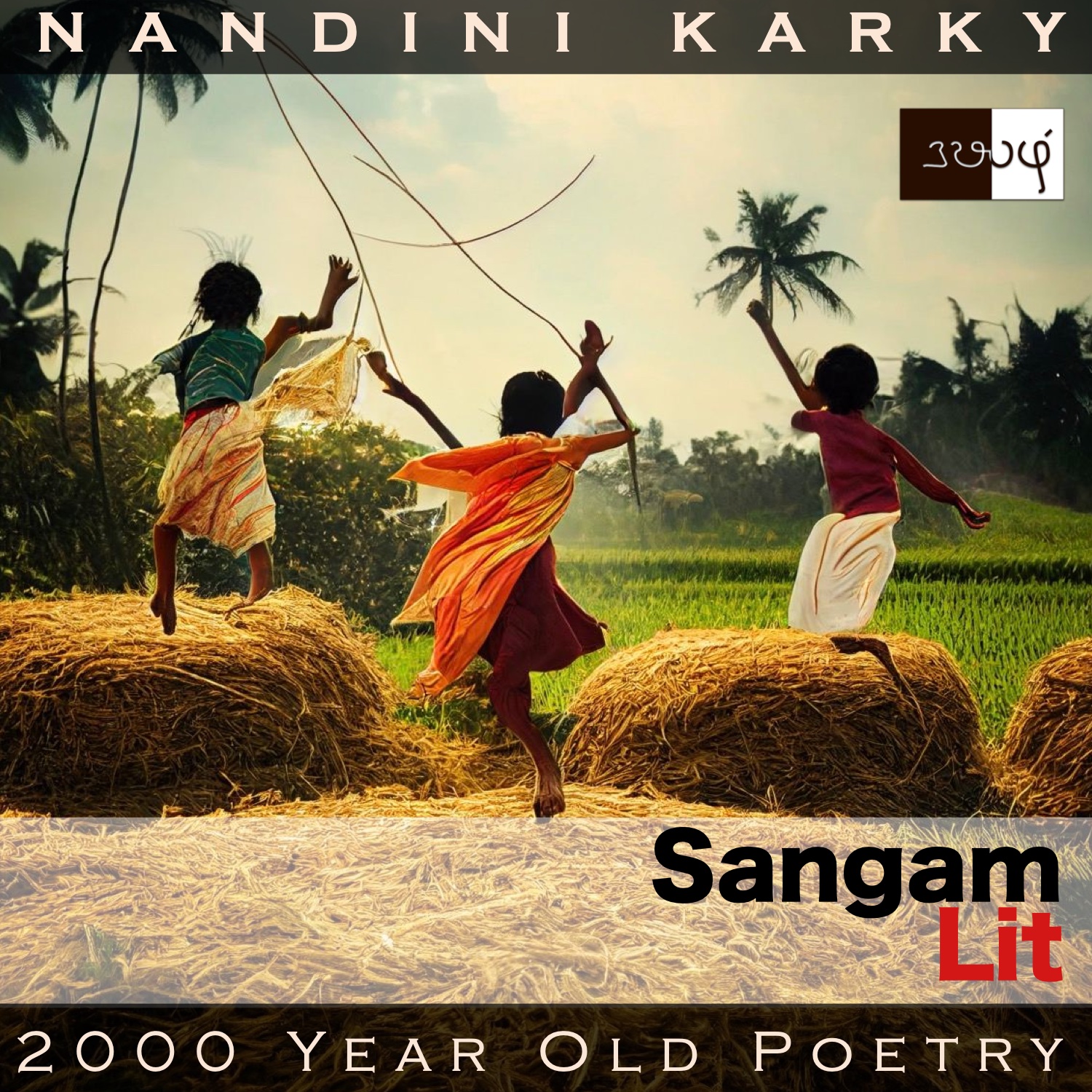Podcast: Play in new window | Download
Subscribe: Apple Podcasts | Spotify | Amazon Music | Android | iHeartRadio | TuneIn | RSS | More
In this episode, we perceive the riches in a king’s country, as depicted in Sangam Literary work, Puranaanooru 61, penned about the Chozha King Ilavanthikaippalli Thunjiya Nalankilli Chetchenni by the poet Erichaloor Maadalan Madurai Kumaranaar. Set in the category of ‘Vaagai Thinai’ or ‘King’s victory’, the verse describes the state of the king’s enemies and proteges.

கொண்டைக் கூழைத் தண் தழைக் கடைசியர்
சிறு மாண் நெய்தல் ஆம்பலொடு கட்கும்,
மலங்கு மிளிர், செறுவின் தளம்பு தடிந்து இட்ட
பழன வாளைப் பரூஉக் கண் துணியல்
புது நெல் வெண் சோற்றுக் கண்ணுறை ஆக,
விலாப் புடை மருங்கு விசிப்ப மாந்தி,
நீடு கதிர்க் கழனிச் சூடு தடுமாறும்
வன் கை வினைஞர் புன் தலைச் சிறாஅர்
தெங்கு படு வியன் பழம் முனையின், தந்தையர்
குறைக்கண் நெடும் போர் ஏறி, விசைத்து எழுந்து
செழுங் கோள் பெண்ணைப் பழம் தொட முயலும்,
வைகல் யாணர், நல் நாட்டுப் பொருநன்,
எஃகு விளங்கு தடக் கை இயல் தேர்ச் சென்னி,
சிலைத் தார் அகலம் மலைக்குநர் உளர்எனின்,
தாம் அறிகுவர் தமக்கு உறுதி; யாம் அவன்
எழு உறழ் திணி தோள் வழு இன்று மலைந்தோர்
வாழக் கண்டன்றும் இலமே; தாழாது,
திருந்து அடி பொருந்த வல்லோர்
வருந்தக் காண்டல், அதனினும் இலமே.
A long song that celebrates the land of this Chozha king Chenni, who was the son of King Nalankilli. The poet’s words can be translated as follows:
“Farming women wearing their hair in a bun, adorned with cool leaves, weed out the little-favoured blue lotus and white lilies, in the farm fields, where eels leap about. And here, the sluices chop up scabbard fish in the field’s waters. Pouring these fleshy pieces of fish atop cooked white rice from new paddy, farmers eat so much that their ribs stick out. In the fields, they look around in confusion, wondering where to place their harvest of long sheaths of grain. Such is the state of these farm workers with strong hands! As for their sparse-haired children, disliking the huge fruits that fall from the coconut tree, they climb on the hay stacks, belonging to their fathers, and jump up furiously trying to touch the fleshy fruit of the palmyra tree. Such is the prosperity of the land, ruled over by Chenni, the leader with adorned chariots, in whose mighty hands, spears glow, and on whose chest, garlands lie low!
If there are those who intend to oppose him, they should know what will become of them. I have never seen those who oppose his strong shoulders akin to a fortress live another day; More than that, I have never seen those who bend low and seek his protection, without any hesitation, live in a state of worry!”
Time to delve into the nuances of this verse! To describe the king’s domain, the poet starts by painting a portrait of not royal women but women working in the fields. He sketches their hairdo which happens to be rolling the hair in a bun and adorning it with leaves. Sensible hairdo for these women, working outdoors and dealing with the hot sun! From their appearance, he moves to their actions and points out how they are efficiently removing the blue lotuses and white lilies blooming in the paddy fields. Note how luxurious objects of beauty, which these flowers are, are chopped away without a thought, from that field. The lens moves from the flowers stalks being cut down to the waters that abound in the field, and as if it were a lake or a river, fish like eel and scabbard fish abound. When the scabbard fish passes through the sluices, it gets chopped up and these are gathered by the farm workers. Going home, they cook fresh white rice and relish these fleshy fish with mounds of rice. So much so that their bellies expand and ribs stick out. It made me smile to think that this poet is talking about potbellies two thousand years ago! But not surprising, as that’s the gift of an agricultural way of food and life!
Returning, next we see these farmers scratching their heads, wondering where to place the copious collection of grain sheaths from their fields. And nearby, the farmers’ young children, not satisfied with coconut fruits that fall from the trees, seem to want only the palmyra fruit growing above, and so they climb on hay stalks and start jumping up to reach those tall trees. While these may seem like mere scenes from an agricultural farm, if one observes closely, it’s an account of a land of plenty. Women, who are known to seek out flowers are casting them aside as unwanted in a field of grains; Next, farmers eat so much that their bellies extend out and there is so much grain being harvested that they don’t even know where to put it. And, even in the scene of young children climbing on haystacks to seek the tall palm’s fruit, there’s a hidden message of those haystacks towering to the skies. After detailing the fertility of the king’s land, the poet then talks about the king’s mighty hands wielding spears, his well-adorned chest and chariots. He concludes by rendering a warning to those who want to oppose the king, saying he’s never seen anyone who did so, live in peace, and at the same time, he has never seen anyone who took refuge with the king, suffer even for a moment. Indeed, it’s but a song of praise to a king but within that wrapper, we are presented with a vivid documentary of farm life from the Sangam times, etched with details like a farm woman’s hairstyle, a labourer’s protruding belly and leaping children on haystacks!




Share your thoughts...